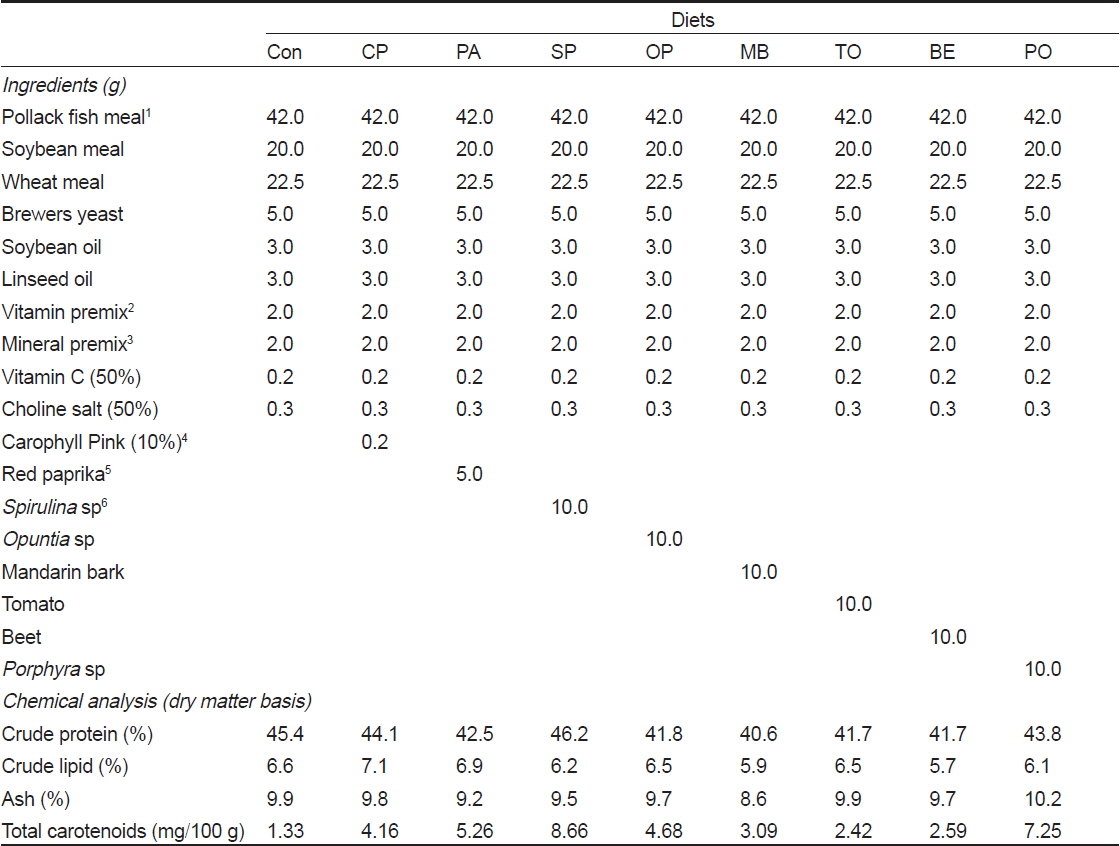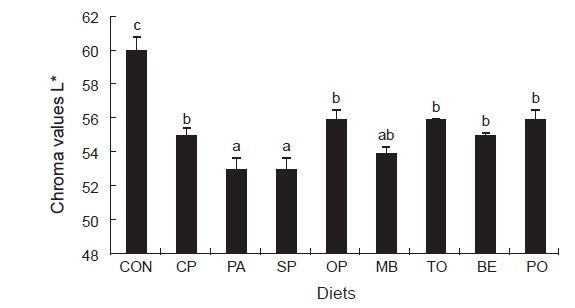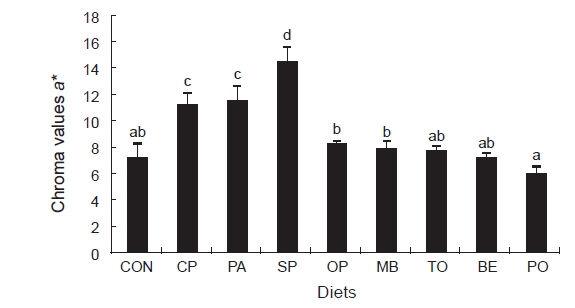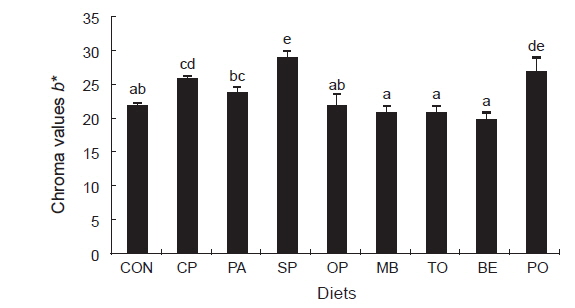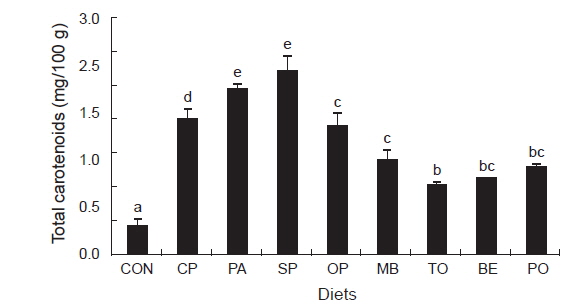비단잉어(Cyprinus carpio)는 아름다운 체색과 다양한 체형을 가지고 있을 뿐 아니라, 수온 및 pH 등의 수질 변화에 내성이 강하여 다른 관상어에 비해 사육관리가 쉽다. 이러한 장점들 때문에 비단잉어는 우리나라를 비롯한 일본, 미국, 유럽 등의 선진국에서 인기가 매우 높은 품종이다(Hancz et al., 2003). 국내에서 비단잉어는 충북, 전남 및 경남 등에서 생산되어 유통되고 있으며, 규모가 큰 곳은 충북 진천의 진천관상어조합이며, 1991년부터 영어조합법인을 설립하여 유럽, 미국 및 일본 등에 비단잉어를 수출하고 있다.
비단잉어의 평가기준은 체형, 지느러미의 형태 및 크기, 유영패턴, 표피의 체색 무늬의 위치 및 모양, 표피의 색상 등 다양하다. 특히, 무늬를 포함한 표피의 선명한 색상이 비단잉어의 가치를 높이는 중요한 기준이 된다. 그래서 비단잉어 양어가, 동호인 및 연구자들은 비단잉어 표피의 발색을 향상시키기 위하여 다양한 시도와 연구를 하고 있다(Nandeesha et al., 1998; Gouveia and Rema, 2005, Kim et al., 2008). 어류의 발색에 관여하는 색소는 지용성의 적황색 carotenoids계이다(Simpson et al., 1981). 그러나 어류를 포함한 대부분의 척추동물들은 carotenoids계 색소를 생합성할 수 없으므로 carotenoids 함량이 높은 식물, 해조류, 플랑크톤, 균류 등을 섭취하여 체내에 축적한다(Torrissen et al., 1989; Storebakken and No, 1992). 연구자들은 사료에 첨가되고 있는 합성색소를 대체하기 위한 연구에서 미세조류나 red paprika를 색소첨가제로 사용하면 비단잉어 표피의 색을 개선할 수 있다고 보고하였다(Gouveia et al., 2003; Kim et al., 2008; Kim and Lee, 2012a, 2012b). 또한 carotenoids의 성분에 따른 연구에서 사료에 astaxanthin, zeaxanthin 및 cantaxanthin이 비단잉어나 금붕어 표피 색택 개선에 효과가 있음을 보고하였다(Matsuno et al., 1979; Nandeesha et al., 1998; Gouveia and Rema, 2005, Kim et al., 2008; Kim and Lee, 2012a).
기존에 연구된 색소원료인 미세조류의 경우, 미세조류를 배양하는데 소요되는 생산비가 높고, 합성색소의 경우에는 판매가격이 매우 비싸고 안전성에 대한 검정 결과가 부족하므로, 비단잉어의 상품가치를 향상시킬 수 있는 색소원료에 대한 연구는 계속되어야 할 것이다. 따라서 본 연구는 배합사료에 첨가할 수 있는 다양한 식물성 천연색소원료들을 탐색하여 이 원료들을 사료에 첨가하여 비단잉어 홍백 치어의 성장 및 표피 색택 개선에 미치는 효과를 조사하기 위해 수행되었다.
실험사료는 Table 1에 표시한 바와 같이 색소원료가 함유되지 않은 대조사료(Con)에 파프리카 분말(red paprika)이 5% 첨가된 사료(PA), 백련초 분말(Opuntia sp., OP), Spirulina sp. (SP), 감귤 껍질 분말(mandarin bark, MB), 붉은 토마토 분말(red tomato, TO), beet (BE), 김분말(Porphyra sp., PO)를 각각 10% 첨가한 8개의 배합사료를 설계하였다. 또한, 천연 색소 원료와 비교하기 위하여 인공 색소 첨가제로 10%의 astaxanthin이 함유된Carophyll Pink (DSM Nutritional Products Ltd, Basel, Switzerland)를 대조사료에 0.2 g 첨가한 사료(CP)를 설계하여, 총 9개의 실험사료 제조하였다. 설계된 실험사료 원료들을 잘 혼합한 후 원료 1 kg에 증류수 300 g을 가하여 다시 혼합 후 펠렛 제조기로 압출 성형하여, 상온에서 2일간 건조 후 −25℃에 보관하였다. 실험사료의 total carotenoids 함량은 Con사료에서 1.33 mg/100 g으로 가장 낮았으며, PO사료, PA사료 및 SP사료에서 각각 8.66 mg/100 g, 7.25 mg/100 g, 5.26 mg/100 g 순으로 다른 실험사료보다 높게 나타났다. 또한 CA사료와 OP사료에서 각각 4.16 mg/100 g, 4.68 mg/100 g으로 나타났으며, 그 외 실험사료에서는 2.42-3.09 mg/100 g 범위로 분석되었다.
실험어로 충청북도내수면연구소에서 종묘 생산된 비단잉어 홍백(fancy carp, Cyprinus carpio var. koi)을 사용하였다. 실험시작 2주전부터 실험조건에 순치된 비단잉어(평균체중: 22.9 g)를 무작위로 각 수조마다 20마리씩 2반복으로 18개의 실험수조(100 L)에 수용한 후, 1일3회 만복으로 실험사료를 8주간 공급하였다. 사육은 여과시스템을 갖춘 시설로 각 수조에 2 L/min의 여과된 담수를 흘려 주었으며, 사육수온은 27℃가 되도록 조절하였다.
실험사료의 일반성분은 AOAC (1995) 방법에 따라 실시하였다. 조단백질(N×6.25)은 Auto Kjeldahl System (Buchi B-324/435/412, Switzerland)을 사용하여 분석하였고, 조지질은 Soxhlet Eextractor (SER 148, VELP Scientifica, Milano, Italy)에서 ether를 사용하여 추출하였으며, 수분은 105℃의 건조기에서 6시간 건조 후 측정하였다. 회분은 600℃의 회화로에서 4시간 동안 태운 후 측정하였다. 실험사료와 어류 표피의 total carotenoids 함량은 Kim and Lee (2012a)이 사용했던 방법에 따라 분석하였다. 즉, 시료를 동결건조 후, 아세톤과 메탄올혼합액(1:1,v/v)으로 암소에서 3회에 걸쳐 조지질을 추출하였다. 추출액에 petroleum ether와 다량의 물로 분리하여 carotenoids를 petroleum ether로 전용시킨 후 무수 Na2SO4로 탈수시키고, 40℃ 이하에서 감압 농축하고, petroleum ether로 100 mL정량하여 UV-spectrometer 사용하여 total carotenoids 함량을 계산하였다.
색도분석을 위해 실험 종료후 전 개체에 대하여 색차계(Minolta Chroma Meter CR-400, Japan)를 이용하여 Lee et al. (2010)이 사용한 방법에 따라 L* (lightness), a* (redness) 및 b*(yellowness)를 측정하였다. 이때 비단잉어 등쪽 표피의 빨간색 부위를 3회 반복하여 측정하였다.
결과의 통계 처리는 SPSS Version 12 (SPSS, Michigan Avenue, Chicago, IL, USA) program을 사용하여 One-way ANOVA-test를 실시 한 후, Duncan`s multiple range test (Duncan, 1955)로 평균간의 유의성을 검정하였다.
사육실험 8주 후의 비단잉어 홍백 치어의 생존, 성장 및 사료효율을 Table 2에 표시하였다. 사육실험기간 동안의 생존율은 95% 이상으로 모든 실험구간에 통계적인 차이는 없었다(P>0.05). Spirulina 분말 첨가구(SP)의 증중율과 사료효율이 가장 높은 값을 나타내었으며, 대조구보다 유의하게 높았다(P<0.05). Beet 분말 첨가사료(BE)를 섭취한 비단잉어의 증중율과 사료효율은 다른 실험구보다 낮았다(P<0.05).
본 연구 결과와 같이 사료의 carotenoids의 원료 및 농도가 어류의 생존율과 성장에 영향을 미친다는 결과들이 보고되어 있다(Amar et al., 2001; Chien and Shiau, 2005; Segner et al., 1989). 반면에 사료의 carotenoids의 원료 및 농도가 어류의 생존율과 성장에 영향을 미치지 않았다는 연구 결과도 발표되고 있다(Rehulka, 2000; White et al., 2003; Kalinowski et al., 2005; Wang et al., 2006). 이는 대상어종 및 사료 내 색소 농도나 사육 환경 등에 따른 차이로 해석된다. 본 실험에서는 Spirulina 첨가 사료를 섭취한 비단잉어의 성장 및 사료효율이 대조구에 비해 유의하게 높은 값을 나타내었다. 비단잉어의 경우, 사료에 Spirulina 분말 첨가가 성장 및 사료효율에 좋은 영향을 미친다는 보고와 영향을 미치지 않는다는 결과들이 보고된 바 있다(Gouveia L., 2003; Kim et al., 2008; Kim and Lee, 2012a; Sun et al., 2012). Spirulina는 품종이 다양하므로 Spirulina종, 배양방법 및 가공방법에 따라 그들의 영양성분이 달라져 어류의 성장에 영향을 미칠 수 있으며(Nandeesha et al., 1998), 사료 조성, Spirulina 첨가량 및 사육환경에 따라서도 어류의 성장과 사료효율에 영향을 미칠 수 있기 때문에 이러한 차이가 생긴 것으로 생각된다.
사육실험 종료시의 비단잉어 홍백 표피 붉은색 부위의 밝기(lightness) L* 값을 Fig. 1에 나타내었다. 사육 8주 후에 L* 값은 53-60 범위였으며, 대조구(Con)의 L* 값이 다른 실험구보다 유의하게 높았다(P<0.05). 특히, Spirulina 분말 첨가구(SP)와 paprika분말 첨가구(PA)가 가장 낮은 L* 값을 나타내었으며(P<0.05), 감귤피분말 첨가구(MB)와는 유의차가 없었다(P>0.05). 실험 종료시 비단잉어 홍백 표피 붉은색 부위의 적색도(redness) a* 값을 Fig. 2에 나타내었다. 사육 8주 후에 a* 값은 6.1-14.8의 범위였으며, 합성색소 첨가구(CP), paprika 첨가구(PA)와 Spirulina 첨가구(SP)들이 대조구보다 유의하게 높았으며, Spirulina 첨가구(SP)의 값이 14.8로 다른 실험구보다 유의하게 가장 높았다(P<0.05). OP, MB, TO, BE 및 PO 실험구들은 대조구와 비교하여 유의한 차이는 없었다(P>0.05). 실험 종료시 비단잉어 홍백 표피 붉은색 부위의 노랑색(yellowness) b* 값을 Fig. 3에 나타내었다. 사육 8주 후에 b* 값은 20-29의 범위였고, 대조구와 비교하여 CP, SP 및 PO 실험구에서 유의하게 높았으며 (P<0.05), SP 실험구에서 29로 가장 높은 값을 나타내었다.
이전에 수행된 연구들에서도 색소가 첨가되지 않은 사료를 섭취한 어류의 표피 L* 값은 색소 첨가 사료를 섭취한 어류의 표피 L* 값보다 높은 값을 보여 본 연구의 결과와 유사하였다(Kim et al., 2013; Kim and Lee, 2012a; Lee et al., 2010). 본 실험에서 비단잉어 표피의 L* 값은 a* 값의 변화와 반대 경향을 보였는데, 다른 연구들에서도 이와 같은 경향을 보였다(Kim and Lee, 2012; Lee et al., 2010).
본 연구에서 Spirulina, paprika 또는 Carophyll Pink 첨가 사료를 섭취한 비단잉어의 표피 적색도를 나타내는 a* 값이 대조구보다 높은 것으로 나타나, Spirulina, paprika와 Carophyll Pink를 비단잉어 색택 개선을 위한 색소제로 사용할 수 있을 것으로 판단된다. Spirulina, paprika, Carophyll Pink 첨가구 외 OP, MB, TO, BE 및 PO 첨가구들의 a* 값은 대조구와 차이를 보이지 않은 것으로 보아, 이들 색소 첨가제는 비단잉어 표피 색택 개선 효과는 없거나 낮은 것으로 보인다.
Gouveia et al. (2003)은 색소원료로 synthetic astaxanthin, Spirulina sp., Chlorella sp. 및 Haematococcus pluvialis를 사용한 실험에서 소화삼색의 경우 synthetic astaxanthin, Spirulina sp. 및 Chlorella sp. 실험구에서 적색도가 높게 나왔으며, 홍백의 경우 synthetic astaxanthin, Chlorella sp. 및 H. pluvialis 첨가구에서 적색도가 높게 나타났다고 보고하였다. Kim et al.(2008)은 다양한 색소원 첨가 실험에서는 synthetic astaxanthin과 Spirulina sp. 실험구에서 적색도가 높게 나타났다고 하였으며, Kim and Lee (2012a)의 실험에서는 paprika와 cantaxanthin 실험구에서 적색도가 높게 나타났다고 보고하였다. 이처럼 실험 대상종 및 크기, 색소원의 종류 및 농도, 사료조성 및 실험조건에 따라 실험 결과가 다양하게 나타났다. 본 연구에서 Spirulina 분말 첨가 사료를 섭취한 비단잉어 표피의 a* 값이 가장 높게 나타났는데, 다른 연구에서도 유사한 결과(Gouveia et al., 2003, Kim et al., 2008)를 나타내었다. 반면에 Kim and Lee (2012a)의 연구에서는 Spirulina 첨가구에서 비단잉어 적색도가 개선되지 않았다고 보고하여 본 연구와 차이를 보이고 있다. 이러한 차이는 Spirulina의 품종에 따른 화학성분의 차이에 의한 것으로 생각된다. Spirulina는 S. maxima, S. platensis, S. pacifica 등 종류가 다양하여 Spirulina 종류, 배양방법 및 가공방법에 따라 어류의 성장 및 체색개선에 미치는 효능이 달라진다고 보고된 바 있다(Kim, 2008; Nandeesha et al., 1998). 본 실험에 사용한 Spirulina는 미국에서 수입한 S. pacifica 이며, Gouveia et al. (2003)의 첨가 실험에서 Arthrospira maxima를 사용하였고, Kim et al. (2008)의 실험에서는 중국에서 배양 및 가공된 S. platensis를 사용하여 실험들 간에 차이가 있다. 또한, Kim (2008)은 S. pacifica와 S. platensis를 원료로 하여 수온 27℃에서 비단잉어 홍백을 대상으로 한 실험결과에서도 S. pacifica를 첨가한 실험구가 S. platensis를 첨가한 실험구보다 적색도가 더 좋아진다는 결과를 발표한 바 있어, 이러한 차이에 대한 판단을 뒷받침해 주고 있다.
실험 종료시 비단잉어 홍백 표피 total carotenoids 값을 Fig. 4에 나타내었다. 대조구에서 0.37 mg/100 g으로 가장 낮았으며, 색소원료가 첨가된 모든 실험구들의 total carotenoids 값이 대조구보다 높은 값을 나타내었다(P<0.05). SP 실험구(2.33 mg/100 g)와 PA 실험구(2.11 mg/100 g)에서 가장 높았으며, 다음으로는 CP와 OP 실험구, MB와 PO 실험구, BE와 TO 실험구 순으로 나타났다(P<0.05). 어류의 carotenoids 축적은 carotenoids 원료, 구조, 안정성, 색소량, 사료 지질, 어체 크기, 성 성숙, 유전, 환경적인 요인 등에 영향을 받는다고 보고되었다(Guillaume et al., 2001). 본 실험에서 대조구에 비해 색소원료 첨가 실험사료를 섭취한 비단잉어 표피의 total carotenoids의 함량이 높았는데, 다른 연구에서도 이와 유사한 결과들이 보고되어 있다(Gouveia et al., 2003; Kim and Lee, 2008; Kim and Lee, 2012a). 또한, 표피의 total carotenoids 함량이 높은 비단잉어는 표피의 a* 값도 높은 것으로 나타났는데, 다른 연구 결과(Lee et al., 2010; Kim et al., 2013)에서도 유사한 경향을 보였다.
본 연구에서 배합사료에 첨가되는 carotenoids 원료에 따른 비단잉어 홍백 치어의 성장 및 체색에 미치는 영향을 알아본 결과, 성장, 사료효율 및 표피의 적색도 개선을 위해 Spirulina pacifica 10%를 사료에 첨가하는 것이 적합하다고 판단되며, red paprika 5% 첨가 사료도 표피의 적색도 개선에 효과가 인정된다.




